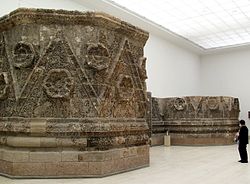Arabesque

Arabesque is an artistic decoration. It uses "surface decorations based on... interlacing foliage, tendrils" or plain lines.[1] Another definition is "Foliate ornament, used in the Islamic world, typically using leaves... combined with spiralling stems".[2]
Arabesques are usually of a single design which can be 'tiled' or repeated as many times as desired.[3]
The term "arabesque" is used as a technical term by art historians for decoration in Islamic art from about the 9th century onwards, and European decorative art from the Renaissance onwards. Note that Islamic geometric patterns are a different style from arabesques.
Arabesque Media
Part of a 15th-century ceramic panel from Samarkand (Uzbekistan) with white calligraphy on a blue arabesque background
Arabesque pattern behind hunters on ivory plaque, 11th–12th century, Egypt
Three modes: arabesques, geometric patterns, and calligraphy used together in the Court of the Myrtles of Alhambra (Granada, Spain)
The French sense of arabesque: a Savonnerie carpet in the Louis XIV style, c.1685–1697, wool, Metropolitan Museum of Art, New York City
The "Arabesque Room" in the Catherine Palace, with neoclassical grotesque decoration
Mosaics on the Treasury Dome of the Great Mosque of Damascus, 789, still in essentially Byzantine style
Palace facade from Mshatta in Jordan, c.740, now in the Pergamon Museum (Berlin)
Panel with horse heads, 11th century, in the Metropolitan Museum of Art, New York City
References
- ↑ Fleming, John & Honour, Hugh 1977 (1989). Dictionary of the decorative arts. Penguin. ISBN 978-0-670-82047-4.
{{cite book}}: CS1 maint: multiple names: authors list (link) - ↑ Rawson, Jessica 1984. Chinese ornament: the lotus and the dragon. British Museum Publications, p236. ISBN 0-7141-1431-6
- ↑ Robinson, Francis 1996 (2002). The Cambridge illustrated history of the Islamic world. Cambridge University Press. ISBN 978-0-521-66993-1.
+{{{1}}}−{{{2}}}









